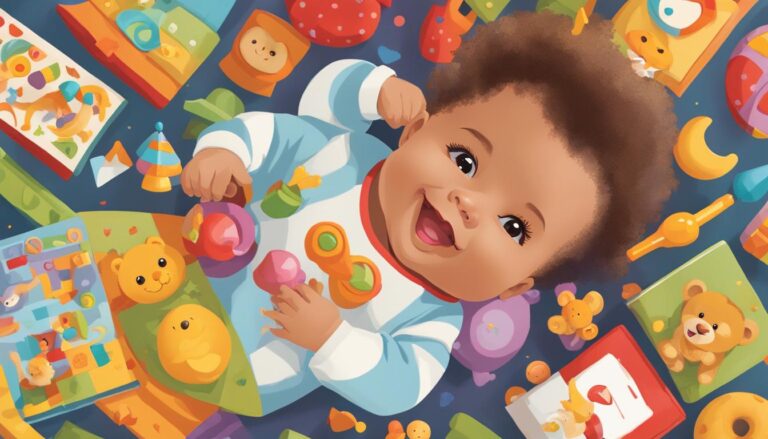Decoding Baby Cries: What Your Baby is Trying to Tell You
As a parent, understanding your baby’s cries is an essential skill that can greatly enhance your ability to care for your little one. Babies have their own unique language expressed through crying, and being able to decode their cries can help you meet their needs and ensure their well-being. In this article, I’ll explore the different reasons why babies cry and how you can better understand and respond to their cries.
When it comes to baby care, it’s crucial to pay attention to the distinct sounds and patterns of your baby’s cries. By doing so, you can identify if they are hungry, tired, uncomfortable, sick, or simply bored. This understanding will enable you to provide the necessary comfort and support to keep your newborn happy and healthy.
Key Takeaways:
- Familiarize yourself with the different reasons why babies cry such as hunger, tiredness, discomfort, sickness, and boredom.
- Recognize the specific sounds and patterns in your baby’s cries to better respond to their needs.
- Consider utilizing the Dunstan Baby Language, a method that helps interpret baby cries based on specific vocal reflexes.
- Understanding your baby’s cries can strengthen the parent-child bond and promote healthy development.
- Seek further guidance on infant nutrition, baby safety, feeding techniques, pediatric health, breastfeeding, baby sleep, and child development to provide the best care possible for your baby.
The Top 8 Reasons Why Your Baby is Crying
Babies cry for various reasons, and as parents, it’s important to understand the different types of cries and what they may indicate. Here are the top 8 reasons why babies cry:
- Hunger: One of the most common reasons for crying in newborns is hunger. If your baby is crying and it has been a while since their last feeding, they may be signaling that they are hungry.
- Tiredness: Just like adults, babies become tired and need rest. Crying may be a sign that your baby is tired and in need of sleep.
- Discomfort: Babies can become uncomfortable for various reasons, such as a wet or dirty diaper, being too hot or cold, or having clothing that is too tight. Crying can be their way of communicating their discomfort.
- Sickness: If your baby is crying inconsolably and you’ve ruled out hunger, tiredness, and discomfort, it’s possible that they may be feeling unwell. It’s important to monitor their temperature and behavior for any signs of illness.
- Feeling Uncomfortable: Babies may cry if they are experiencing physical discomfort, such as gas or colic. They may have trouble settling and cry in discomfort.
- Overstimulation: Babies have sensitive nervous systems and can become overwhelmed by too much noise, bright lights, or excessive activity. Crying in response to overstimulation is a way for them to seek calm and quiet.
- Colic: Colic is defined as inconsolable crying in an otherwise healthy baby. It typically occurs in the late afternoon or evening and can last for hours. The exact cause of colic is unknown, but it is believed to be related to digestive issues or an immature digestive system.
By understanding these common reasons for crying, you can better address your baby’s needs and provide the appropriate comfort and care they require.
Table: Types of Baby Cries and Their Characteristics
| Type of Cry | Characteristics | Possible Cause |
|---|---|---|
| Hungry Cry | Short, low-pitched cries | Signifies hunger and the need for feeding |
| Tired Cry | Soft, whining cries | Indicates fatigue and the need for sleep |
| Discomfort Cry | Continuous, high-pitched cries | Signals discomfort such as a wet diaper, cold or hot environment, or tight clothing |
| Sick Cry | Weak, whimpering cries | Suggests illness or discomfort due to an underlying health issue |
| Uncomfortable Cry | Sharp, intense cries | Related to physical discomfort such as gas or colic |
| Overstimulated Cry | Frantic, high-pitched cries | Occurs when the baby becomes overwhelmed by excessive noise or activity |
| Colicky Cry | Intense, prolonged crying episodes | Characterized by inconsolable crying, often in the late afternoon or evening |
It’s important to note that every baby is unique and may display variations in their crying patterns. By paying attention to your baby’s cues and combining it with your parental instincts, you can develop a better understanding of their needs and provide the care and comfort they require.
Understanding the Dunstan Baby Language
The Dunstan Baby Language, developed by Priscilla Dunstan, offers a unique method for parents to interpret their baby’s cries. Through years of research, Dunstan discovered that babies of all races and cultures make distinctive sounds before they start crying. By understanding these vocal reflexes, parents can decode their baby’s cries and address their needs effectively.
According to Dunstan, there are five main sounds that babies make: “neh” for hunger, “eh” for the need to burp, “eairh” for lower wind/gas, “heh” for discomfort, and “owh” for sleepiness. By recognizing these specific sounds, parents can gain valuable insights into what their baby is trying to communicate.
“The Dunstan Baby Language has truly been a game-changer for me as a parent. It has given me the ability to understand and respond to my baby’s needs with more confidence and ease,” says Rachel, a mother of two.
The Power of the Dunstan Baby Language
Studies have shown that the Dunstan Baby Language is highly accurate in interpreting baby cries, with accuracy rates ranging from 89% to 94.7%. By mastering this language, parents can build a stronger bond with their baby and provide the care they need to thrive.
Understanding the Dunstan Baby Language can be a valuable tool in your parenting journey. It empowers you to support your baby’s wellbeing by accurately interpreting their cries and responding appropriately. By utilizing this method, you can navigate the challenges of parenting with greater confidence and provide the best care for your little one.

| Sound | Meaning |
|---|---|
| neh | hunger |
| eh | burp |
| eairh | lower wind/gas |
| heh | discomfort |
| owh | sleepiness |
Conclusion
Understanding baby cries is crucial for parents to provide optimal care and meet their baby’s needs. By decoding their cries, parents can effectively respond to hunger, tiredness, discomfort, sickness, and other issues that may arise. This understanding becomes even more valuable when using the Dunstan Baby Language, which can help identify specific sounds and cues in a baby’s cry.
As parents gain a better understanding of their baby’s cries, they not only build a stronger bond but also promote healthy development and ensure overall well-being. However, it is important to remember that decoding cries is just one aspect of parenting. Seeking further guidance on infant nutrition, baby safety, feeding techniques, pediatric health, breastfeeding, baby sleep, and child development is vital to provide the best possible care for your baby.
Infant nutrition plays a significant role in their growth and development. Consulting with healthcare professionals and following expert advice can help you make informed decisions about your baby’s diet. Additionally, prioritizing baby safety by creating a safe environment, following safety guidelines, and staying updated on the latest safety recommendations is essential.
Feeding techniques, such as breastfeeding or bottle feeding, require careful attention to ensure your baby receives proper nourishment. Pediatric health should never be neglected, and regular check-ups with a healthcare provider will help monitor your baby’s growth and address any concerns. Adequate sleep is crucial for both babies and parents, so establishing healthy sleep routines and seeking guidance on infant sleep can contribute to a well-rested household.
Lastly, understanding child development milestones and promoting age-appropriate activities will support your baby’s cognitive, emotional, and physical growth. By investing time in learning about these topics, you are equipping yourself with the knowledge and skills to provide the best care possible for your baby, enhancing their overall well-being and setting the foundation for a healthy and happy life.
FAQ
How can I differentiate between different types of baby cries?
By recognizing specific sounds and patterns, you can distinguish between cries related to hunger, tiredness, discomfort, sickness, and other needs.
What are the top reasons why babies cry?
The top 8 reasons babies cry include hunger, tiredness, discomfort, sickness, feeling uncomfortable, overstimulation, colic, and having a dirty nappy.
What is the Dunstan Baby Language?
The Dunstan Baby Language is a method developed by Priscilla Dunstan that helps parents interpret their baby’s cries based on specific vocal reflexes, such as “neh” (hunger), “eh” (burp), “eairh” (lower wind/gas), “heh” (discomfort), and “owh” (sleepiness).
How accurate is the Dunstan Baby Language in interpreting baby cries?
Studies report accuracy rates between 89% and 94.7% for the Dunstan Baby Language in interpreting baby cries across different races and cultures.






